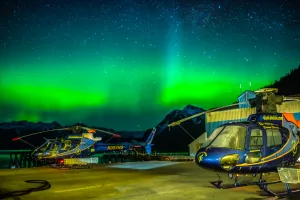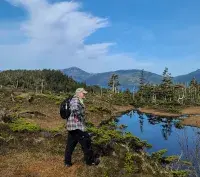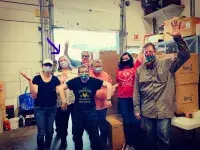
When many people think of Alaska, they think polar bears and snow – lots of snow. The image of the rugged, self-sustaining individualist and maybe the misty glaciered bays, majestic mountains and legendary howling winds and wolves across the tundra have lured more than one searching soul to this rugged paradise.
But for LTSO David Little and TSO Katherine Mead, there is another common thread to how they arrived at Merle K. (Mudhole) Smith Airport (CDV) in Cordova, Alaska. It doesn’t take a person long to discover Alaska is a place where you can feel a part of the community. The fit was seamless for both Little and Mead as they effortlessly became part of Cordova’s daily life.
“TSA brought me to Alaska, and once here, I was hooked,” said Little. After living in several states and overseas for most of his life, Little arrived in Alaska via Denver International Airport where he signed on with TSA in 2002. He soon rolled out with the National Screening Force (now National Deployment Office - NDO) where he worked for nearly four and a half years. “I intended to stay with the NDO until I retired,” recalled Little. But his time with the NDO was cut short when in 2008 he accepted a position at CDV, and he has never looked back.
My first assignment to Alaska totally shocked me,” said Little. “Here was the biggest state in the USA, and I knew absolutely nothing about it. The sum total of my prior Alaskan exposure was in the 1960s, hearing Johnny Horton sing “North to Alaska.”
As a professional photographer, Little spends at least 10 hours per week scouting out locations and many more working on his photographs. His work has appeared in the local newspaper, The Cordova Times, Alaska magazine and Cordova Chamber of Commerce web pages and advertising materials. His stunning photos have found their way into Alaska Marine Highway advertising campaigns and on Alaska side maps. Little’s photographs are sold at fundraising auctions for numerous local causes in Cordova. Previously, in his spare time, Little served for five years as a member of the Cordova Electric Co-Op.
“David is an amazing tour guide,” said Alaska STSO Elizabeth Crawford-Meliah. “He showed me some amazing areas in the Cordova community and taught me how to capture the local beauty through photography.”
Mead grew up in Pensacola, Florida, where she received her Bachelor of Arts in International Studies. Not one to stay in one place too long, Mead has lived in North Dakota, Minnesota and Missouri. While in Missouri, she worked for a private company at Kansas City International Airport. When she applied for a full-time position at TSA, the only openings were in Alaska. After loading everything she owned into her van, Mead drove the Alaska Canada Highway to Valdez where she took a ferry to Cordova and CDV.
“My parents doubted my critical thinking for a while until they saw how great the fit was,” said Mead.
Having a volunteer fire department background, volunteering and community involvement is a way of life for Mead. She worked with Girl Scouts, hospice, a hospital, fire departments, the Salvation Army and numerous other outreach programs. So it was an easy fit for her in the community-minded small town of Cordova where she has previously served as a medical member of the Cordova Volunteer Fire Department.
“Katherine is always willing to help anyone,” said STSO Rheo Lyno Abary Reroma. “She is very involved with the Cordova community. Katherine has been known to offer her assistance to Cordovans through house sitting and dog (pet) sitting. She has an engaging personality.”
“Life and the challenges of living in remote Alaskan locations is not truly understood until it is experienced first-hand,” said AFSD-G David McDermott. “David and Katherine’s servant leadership to their community and the critical aviation lifeline are a testament to the TSA. Their stories and examples of Alaskan Spirit are mirrored by Team Alaska employees throughout the remote spokes in our Great State.”
By Wayne Carey, Strategic Communications & Public Affairs


